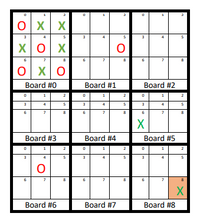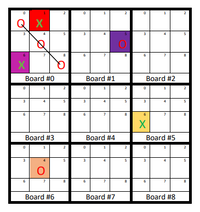
- Write up Java source codes for compiling and execution of program below.
There is a very simple solution to keeping Tic-tac-toe fresh and interesting, though, and it has been thought up by a group of mathematicians. It’s being called Ultimate Tic-tac-toe and simply embeds a Tic-tac-toe board in each of the nine squares of the original game.
Now instead of just winning the main board, you also need to win each of the smaller boards first until you have a line of three.
New Rule: You can only place a mark on the board determined by the position of your opponent’s last placed mark. So, if they put an X or O in the top right corner of a square, your next move must occur in the top right board.
By adding that rule the game is no longer about winning a single board, it’s about tactically managing up to 9 games at once and plotting ahead. You still win by marking three squares in a row, but that now involves winning three games.
The effects of the New Rule:
1: Your opponent can force you to choose an open square in an already won/tie board.
1- Player X Move:
- Board# : 0
- Square#: 1
2- Player O Move: Only valid Board is Board #1
- Square#: 5
3- Player X Move: Only valid Board is Board #5
- Square#: 6
4- Player O Move: Only valid Board is Board #6
- Square#: 4
For example, after a while Board # 0 has a winner, Player O. It is the Player X turn and the only valid Board# for Player X is Board#0
Player X Move: Only valid Board is Board #0
- Square#: 6
2: If the board is already full, you get a free pass to place your mark in any board
For example, after a while Board # 0 is completely full. It is the Player X turn and the only valid Board# for Player X is Board#0. Since Board#0 is full, then the Player X gets to pick any other Board.
Player X Move:
- Board# : 8
- Square#: 8
The great thing about this rule change and board layout is it remains easy to understand.
Basic Rules:
1. Each turn, you mark one of the small squares.
2. When you get three in a row on a small board, you’ve won that board.
3. To win the game, you need to win three small boards in a row.
4. You don’t get to pick which of the nine boards to play on. That’s determined by your opponent’s previous move. Whichever square he picks, that’s the board you must play in next. (And whichever square you pick will determine which board he plays on next.)
- Clarifying rules:
1. What if my opponent sends me to a board that’s already been won/tie but not full? In that case, you get to play on that board, but your move doesn’t affect the outcome of that board.
2. What if my opponent sends me to a board that’s already been full? In that case, congratulations – you get to go anywhere you like, on any of the other boards.
- Write up Java source codes for compiling and execution of program.


Trending nowThis is a popular solution!
Step by stepSolved in 3 steps with 1 images

- THIS IS MEANT TO BE IN JAVA. What we've learned so far is variables, loops, and we just started learning some array today. The assignment is to get an integer from input, and output that integer squared, ending with newline. But i've been given some instructions that are kind of confusing to me. Please explain why and please show what the end result is. Here are some extra things i've been told to do with the small amount of code i've already written... Type 2 in the input box, then run the program so I can note that the answer is 4 Type 3 in the input box instead, run, and note the output is 6. Change the output statement to output a newline: System.out.println(userNumSquared);. Type 2 in the input box Change the program to use * rather than +, and try running with input 2 (output is 4) and 3 (output is now 9, not 6 as before). This is what I have so far... import java.util.Scanner; public class NumSquared {public static void main(String[] args) {Scanner scnr = new…arrow_forwardWrite a java program that will create a Deck object and shuffle the deck. Then, you will draw ten cards from the deck and perform selection statements that carry out the following: If the card is red, then print “Card is red” to the screen. Otherwise, print “Card is black” to the screen. If the card is a picture card, print “That's a picture card”. If the card is an ace, print “That's an Ace”. If the card has a value less than 6, print “Card has a small value”. If the card has a value between 6 and 10 (inclusive), print “Card has a large value”. In the source code, write an algorithm for the program in a comment block. Also, in a comment block, paste the results of running your program. Print out and turn in the completed source code with those comments.arrow_forwardImplement the following in the .NET Console App. Write the Bus class. A Bus has a length, a color, and a number of wheels. a. Implement data fields using auto-implemented Properies b. Include 3 constructors: default, the one that receives the Bus length, color and a number of wheels as input (utilize the Properties) and the Constructor that takes the Bus number (an integer) as input.arrow_forward
- Using the Card.java class file, write a program to simulate a Deck of Cards. See Programming Project 8.7 (PP 8.7) from page 403 of your textbook (or view the attached image) for a description of what your program needs to do. Note that although the book description of the problem states that you should write the Card class, I do not want you to do that. You must use the Card file exactly as it is provided (NO modifications) and only write the DeckOfCards and Driver classes. public class Card{public final static int ACE = 1;public final static int TWO = 2;public final static int THREE = 3;public final static int FOUR = 4;public final static int FIVE = 5;public final static int SIX = 6;public final static int SEVEN = 7;public final static int EIGHT = 8;public final static int NINE = 9;public final static int TEN = 10;public final static int JACK = 11;public final static int QUEEN = 12;public final static int KING = 13; public final static int CLUBS = 1;public final static int DIAMONDS =…arrow_forwardWrite a method that takes two string parameters, and tells whether the first is a substring of the second. You can't use framework methods that do this for you, such as indexOf(). In other words, you have to write the loops yourself. But, you can use the primitive methods such as charAt(). Also analyze the program's performance and state the big-O complexity of your method. Provide a screenshot of the code working.arrow_forwardImplement a python version of the game Hangman in which a player attempts to guess a secret word one letter at a time. Normally Hangman is a two-player game but in your version the user will play three rounds against the computer. Use the following as the secret word in each round: 1. “APPLE”2. “OBVIOUS”3. “XYLOPHONE” Here are the steps to follow in each round: Print the secret word with each letter replaced with the underscore character, “_” Prompt the user to enter a letter or word using the following message, “Enter a letter or word: ”. If the user enters a single letter, check if that letter is in the secret word (case-insensitive). The user can make up to 6 letter guesses in a round. If the user guesses a letter they have already guessed, print the message “You've already guessed that letter!” and don’t count it as one of their 6 guesses. Go straight to step 6. If the user enters a word, check if the word matches the secret word (case-insensitive). Word guesses should not…arrow_forward
- Please help me solve this with java .... just the HangMan HangMan instruction class : • HangMan is a game in which a player tries to guess a word based on a given hint. For example, if the given hint is “movie”, then the player must guess a movie name. If the given hint is a “country”, then the player must guess a country name, and so on.• The game starts by showing a message on the screen that shows the hint and all letters in the word but obscured as dashes (-). Then, the game will allow the player to guess 5 letters. If the player gives a letter that actually exists in the word, then this letter will be revealed. Afterwards, the game will ask the player to give the answer. If the given answer is correct, then the game will show a message that the player has won 5 points. Otherwise, the game will show a message that the player has lost. Below is one possible game scenario, in which the word is “iron man”, and the hint is “movie”. Note that the text in green color is the…arrow_forwardThere are three main operations on rectangles: intersection, union, and difference. Among them, only intersection is guaranteed to return another rectangle. In general, the union of two rectangles is... two rectangles, and the difference between two rectangles is ... a whole lot of rectangles, as we will see. We let you implement rectangle intersection. Of course, the intersection is defined only if the rectangles have the same number of dimensions. The intersection is computed by taking the intersection of the intervals of the two rectangles for corresponding dimensions. If one of the intervals is empty, you should return None. [] # @ title Rectangle intersection def rectangle_and(self, other): if self.ndims != other.ndims: raise TypeError("The rectangles have different dimensions: {} and {}".format( )) self.ndims, other.ndims ### YOUR SOLUTION HERE Rectangle. _and_ = rectangle_and [ ] r1 = Rectangle((2, 3), (0, 4)) r2 = Rectangle((0, 4), (1, 3)) draw rectangles (r1, r2) draw…arrow_forwardI need help making a JAVA codearrow_forward
 Computer Networking: A Top-Down Approach (7th Edi...Computer EngineeringISBN:9780133594140Author:James Kurose, Keith RossPublisher:PEARSON
Computer Networking: A Top-Down Approach (7th Edi...Computer EngineeringISBN:9780133594140Author:James Kurose, Keith RossPublisher:PEARSON Computer Organization and Design MIPS Edition, Fi...Computer EngineeringISBN:9780124077263Author:David A. Patterson, John L. HennessyPublisher:Elsevier Science
Computer Organization and Design MIPS Edition, Fi...Computer EngineeringISBN:9780124077263Author:David A. Patterson, John L. HennessyPublisher:Elsevier Science Network+ Guide to Networks (MindTap Course List)Computer EngineeringISBN:9781337569330Author:Jill West, Tamara Dean, Jean AndrewsPublisher:Cengage Learning
Network+ Guide to Networks (MindTap Course List)Computer EngineeringISBN:9781337569330Author:Jill West, Tamara Dean, Jean AndrewsPublisher:Cengage Learning Concepts of Database ManagementComputer EngineeringISBN:9781337093422Author:Joy L. Starks, Philip J. Pratt, Mary Z. LastPublisher:Cengage Learning
Concepts of Database ManagementComputer EngineeringISBN:9781337093422Author:Joy L. Starks, Philip J. Pratt, Mary Z. LastPublisher:Cengage Learning Prelude to ProgrammingComputer EngineeringISBN:9780133750423Author:VENIT, StewartPublisher:Pearson Education
Prelude to ProgrammingComputer EngineeringISBN:9780133750423Author:VENIT, StewartPublisher:Pearson Education Sc Business Data Communications and Networking, T...Computer EngineeringISBN:9781119368830Author:FITZGERALDPublisher:WILEY
Sc Business Data Communications and Networking, T...Computer EngineeringISBN:9781119368830Author:FITZGERALDPublisher:WILEY





